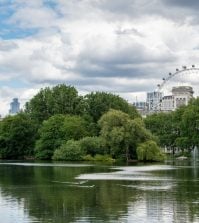From retrofits to investment vehicles: building the infrastructure for green growth

To ‘build back better’, governments must oversee the creation of new infrastructures to decarbonise their economies. At a recent webinar, senior officials from the OECD, Estonia and the Czech Republic discussed how best to fund and manage these changes – and the extent to which COVID-19 has moved the goalposts. Catherine Early reports
Changes to infrastructure and the built environment are a major part of governments’ efforts to transform their economies to ‘net zero’ by 2050. But contrary to what you might expect, “building nothing is the perfect scenario,” according to Dr Kim Yates, UK and Europe sustainability and climate change lead at design and engineering consultancy Mott MacDonald.
While overall carbon emissions in the UK are reducing, those released from the production of construction materials such as steel, concrete and asphalt are still rising, Yates said. One problem is a lack of policy on how to achieve net zero, she noted. And, while it is catching up quickly, engineers have to go above and beyond compliance to build green infrastructure, Yates explained.
Indeed, sustainability must be considered well in advance of construction: Yates argued that big gains in carbon reduction and environmental issues are made when these factors are considered at the very outset of projects. “It’s looking at what you are building. Can you renew an existing asset? Do you really need it? It’s building this thinking in,” she said.
The consideration of what – and even if – you need to build was just one theme discussed at a recent webinar about green infrastructure run by Global Government Forum and supported by knowledge partner Mott MacDonald. Senior representatives from the Organisation for Economic Co-operation and Development (OECD), and the governments of Estonia and the Czech Republic, discussed policy approaches, how to shape finance systems and leverage private sector investment to fund them, and whether the COVID-19 pandemic has altered the challenges facing policymakers and project leaders.
Reduce, retrofit and renovate
Rather than building new, the Czech Republic retrofits infrastructure as part of its decarbonisation strategy, according to Anna Pasková, director of environmental policy and sustainable development at the country’s Ministry of Environment. Since 2009, a retrofit programme has made 36,000 buildings more energy efficient by offering grants for insulation to householders, she said. The next phase of the programme will also offer funding for solar thermal heating systems, green roofs and-water saving technologies.

In Estonia, the government’s strategy has been to take a step back from energy generation and focus on being smarter about usage, according to Ivo Jaanisoo, head of the construction and housing department at the Ministry of Economic Affairs and Communications. “We really want to tap into the cheapest energy potential, which is saved energy,” he said.
Building renovations are a key aspect of this approach. Around half of Estonia’s total energy consumption comes from buildings, compared with an EU average of 40%, said Jaanisoo. The country’s long-term renovation strategy plans to increase annual retrofits of government, residential and commercial buildings from the current level of around 500,000 per year to nearly 2,500,000 by 2035, he said.
Alongside savings in terms of costs, energy and carbon, making buildings more energy efficient can improve indoor air quality, the heritage of old buildings, and the flexibility of spaces to adapt to different uses in the future, Jaanisoo said.
Estonia is also experimenting around how real-time data can guide energy efficiency. Real-time energy consumption data could drive a vibrant market of energy efficiency services and products, noted Jaanisoo. “Real-time consumption data opens the door for real-time carbon footprint measurements so that every building owner can see the potential savings when considering improvements to their building,” he said.
Financing green infrastructure
But even if efficiency is baked into projects, governments still need to finance them from pandemic-torn balance sheets. For this, many are using a combination of public and private sector funding.

The Czech Republic is financing its green infrastructure upgrades through various European funds, including EU Structural Funds and the Modernisation Fund, which supports lower-income member states with decarbonisation, Pasková said. The finance will support programmes including energy saving, renewable energy, new heating plants, clean mobility, and water infrastructure.
The country will also use money from the EU’s economic stimulus programme’s Just Transition Fund to support its decarbonisation work in former coal mining areas, which will also reduce inequality, she said. The European Commission has also stipulated that member states’ investments must pass a “do no harm” test on climate and environment. This could be a “game changer” in the mindset of countries for how they invest funding, she added.
But governments must also create the right environment for institutional investors to support green infrastructure financing, said Dirk Röttgers, policy analyst in Green Finance and Investment at the OECD. Pension funds and insurance companies typically spend a very small portion of their portfolio on infrastructure, he noted.
The four biggest types of institutional investors held US$1.04 trillion in infrastructure such as transport, energy, waste, water and construction, according to research carried out by the OECD. But this is dwarfed by the US$64 trillion held in corporate stocks and bonds, and only US$314 billion of the total could be considered green infrastructure.

Recent research completed by Röttgers shows how policymakers could encourage investors to make their portfolios greener. Governments can intervene to regulate financial markets, or become players in them to leverage investments from institutional funds, he suggested, citing the need to ensure that project pipelines that fulfil policy objectives are available for funds to invest in as an example.
Governments should also ensure they do not unintentionally block investment by banning certain financial instruments, such as YieldCos: investment vehicles formed by a parent company to own operating assets. “It’s a really good instrument and fits the appetite of institutional investors, but they are not allowed in all countries. And there are similar instruments that are geared towards fossil fuel only,” he said.
“Make sure that whoever on the private side wants to invest in these projects can do so, whether it’s a really big investor with huge tranches of finance, or a really small one like your private saver. Governments have to give private finance a chance to cater to them,” Röttgers advised.
Build back better?
But it is not just institutional investors who need encouraging to invest in green infrastructure. A recent OECD analysis revealed that governments were spending roughly the same amount of recovery money on environmentally-positive investments as they were on those with negative impacts, according to Röttgers.
“For governments focusing on these investments, it may pay to be transparent on what they’re actually invested in, set goals on how much needs to be invested in green measures, and be very clear on what not to invest in,” he said. So far, only the European Commission had set those kinds of guidelines, he added.

Other panellists were more optimistic: Yates said that she had never seen so much activity on the issue of low carbon in the infrastructure sector. “We’ve seen an upsurge in inquiries and work, certainly when Biden came in. I can’t see it going down the agenda because I don’t think the citizens will allow it,” she said.
But the needs of the public could change significantly once COVID-19 lockdowns end, with a future of hybrid working predicted by many. Röttgers pointed out that public transport systems might need to be rethought, as people are already moving further out to the suburbs as they are not required in the office five days a week. Networks could be less dense in areas that are now highly populated, but stretch further out, he suggested.
“There may have to be a paradigm shift based on what we need for climate and other environmental reasons anyway. It’s interesting times,” he said.
Others were more cautious. The effect on office use in the Czech Republic should not be overestimated, noted Pasková, since only 30-50% of office workers had worked from home during lockdown. In addition, emissions cuts from reduced commuting could be replaced by increases in those from home deliveries, she said. Here – as across the sustainability agenda – many of the keys to success lie in better understanding the evidence the relationship between economic changes and environmental impacts. “We will have to check the data,” she concluded.























